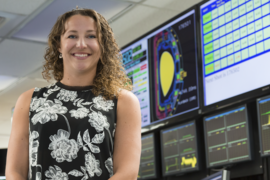Trying to duplicate the power of the sun for energy production on earth has challenged fusion researchers for decades. One path to endless carbon-free energy has focused on heating and confining plasma fuel in tokamaks, which use magnetic fields to keep the turbulent plasma circulating within a doughnut-shaped vacuum chamber and away from the walls. Fusion researchers have favored contouring these tokamak plasmas into a triangular or D shape, with the curvature of the D stretching away from the center of the doughnut, which allows plasma to withstand the intense pressures inside the device better than a circular shape.
Led by research scientists Alessandro Marinoni of MIT's Plasma Science and Fusion Center (PSFC) and Max Austin, of the University of Texas at Austin, researchers at the DIII-D National Fusion Facility have discovered promising evidence that reversing the conventional shape of the plasma in the tokamak chamber can create a more stable environment for fusion to occur, even under high pressure. The results were recently published in Physical Review Letters and Physics of Plasmas.
Marinoni first experimented with the “reverse-D” shape, also known as “negative triangularity,” while pursuing his PhD on the TCV tokamak at Ecole Polytechnique Fédérale de Lausanne, Switzerland. The TCV team was able to show that negative triangularity helps to reduce plasma turbulence, thus increasing confinement, a key to sustaining fusion reactions.
“Unfortunately, at that time, TCV was not equipped to operate at high plasma pressures with the ion temperature being close to that of electrons,” notes Marinoni, “so we couldn’t investigate regimes that are directly relevant to fusion plasma conditions.”
Growing up outside Milan, Marinoni developed an interest in fusion through an early passion for astrophysical phenomena, hooked in preschool by the compelling mysteries of black holes.
“It was fascinating because black holes can trap light. At that time I was just a little kid. As such, I couldn’t figure out why the light could be trapped by the gravitational force exerted by black holes, given that on Earth nothing like that ever happens.”
As he matured he joined a local amateur astronomy club, but eventually decided black holes would be a hobby, not his vocation.
“My job would be to try producing energy through nuclear fission or fusion; that’s the reason why I enrolled in the nuclear engineering program in the Polytechnic University of Milan.”
After studies in Italy and Switzerland, Marinoni seized the opportunity to join the PSFC’s collaboration with the DIII-D tokamak in San Diego, under the direction of MIT professor of physics Miklos Porkolab. As a postdoc, he used MIT’s phase contrast imaging diagnostic to measure plasma density fluctuations in DIII-D, later continuing work there as a PSFC research scientist.
Max Austin, after reading the negative triangularity results from TCV, decided to explore the possibility of running similar experiments on the DIII-D tokamak to confirm the stabilizing effect of negative triangularity. For the experimental proposal, Austin teamed up with Marinoni and together they designed and carried out the experiments.
"The DIII-D research team was working against decades-old assumptions,” says Marinoni. “It was generally believed that plasmas at negative triangularity could not hold high enough plasma pressures to be relevant for energy production, because of macroscopic scale Magneto-Hydro-Dynamics (MHD) instabilities that would arise and destroy the plasma. MHD is a theory that governs the macro-stability of electrically conducting fluids such as plasmas. We wanted to show that under the right conditions the reverse-D shape could sustain MHD stable plasmas at high enough pressures to be suitable for a fusion power plant, in some respects even better than a D-shape."
While D-shaped plasmas are the standard configuration, they have their own challenges. They are affected by high levels of turbulence, which hinders them from achieving the high pressure levels necessary for economic fusion. Researchers have solved this problem by creating a narrow layer near the plasma boundary where turbulence is suppressed by large flow shear, thus allowing inner regions to attain higher pressure. In the process, however, a steep pressure gradient develops in the outer plasma layers, making the plasma susceptible to instabilities called edge localized modes that, if sufficiently powerful, would expel a substantial fraction of the built-up plasma energy, thus damaging the tokamak chamber walls.
DIII-D was designed for the challenges of creating D-shaped plasmas. Marinoni praises the DIII-D control group for “working hard to figure out a way to run this unusual reverse-D shape plasma.”
The effort paid off. DIII-D researchers were able to show that even at higher pressures, the reverse-D shape is as effective at reducing turbulence in the plasma core as it was in the low-pressure TCV environment. Despite previous assumptions, DIII-D demonstrated that plasmas at reversed triangularity can sustain pressure levels suitable for a tokamak-based fusion power plant; additionally, they can do so without the need to create a steep pressure gradient near the edge that would lead to machine-damaging edge localized modes.
Marinoni and colleagues are planning future experiments to further demonstrate the potential of this approach in an even more fusion-power relevant magnetic topology, based on a “diverted” tokamak concept. He has tried to interest other international tokamaks in experimenting with the reverse configuration.
“Because of hardware issues, only a few tokamaks can create negative triangularity plasmas; tokamaks like DIII-D, that are not designed to produce plasmas at negative triangularity, need a significant effort to produce this plasma shape. Nonetheless, it is important to engage the fusion community worldwide to more fully establish the data base on the benefits of this shape.”
Marinoni looks forward to where the research will take the DIII-D team. He looks back to his introduction to tokamak, which has become the focus of his research.
“When I first learned about tokamaks I thought, ‘Oh, cool! It’s important to develop a new source of energy that is carbon free!’ That is how I ended up in fusion.”
This research is sponsored by the U.S. Department of Energy Office of Science's Fusion Energy Sciences, using their DIII-D National Fusion Facility.








